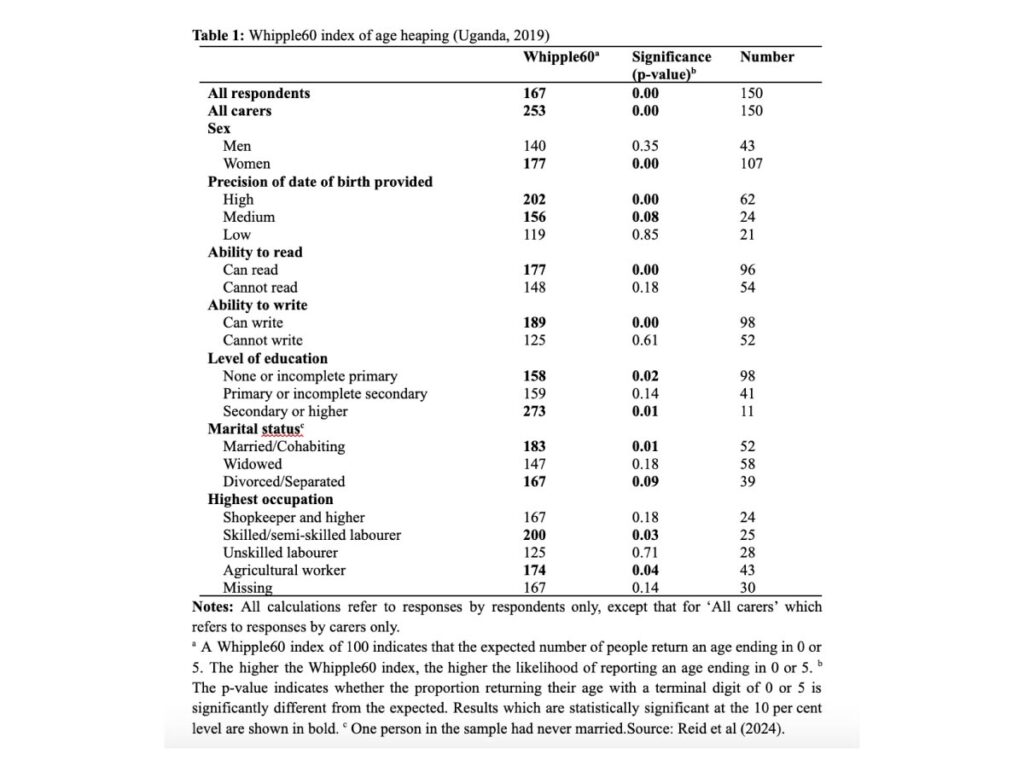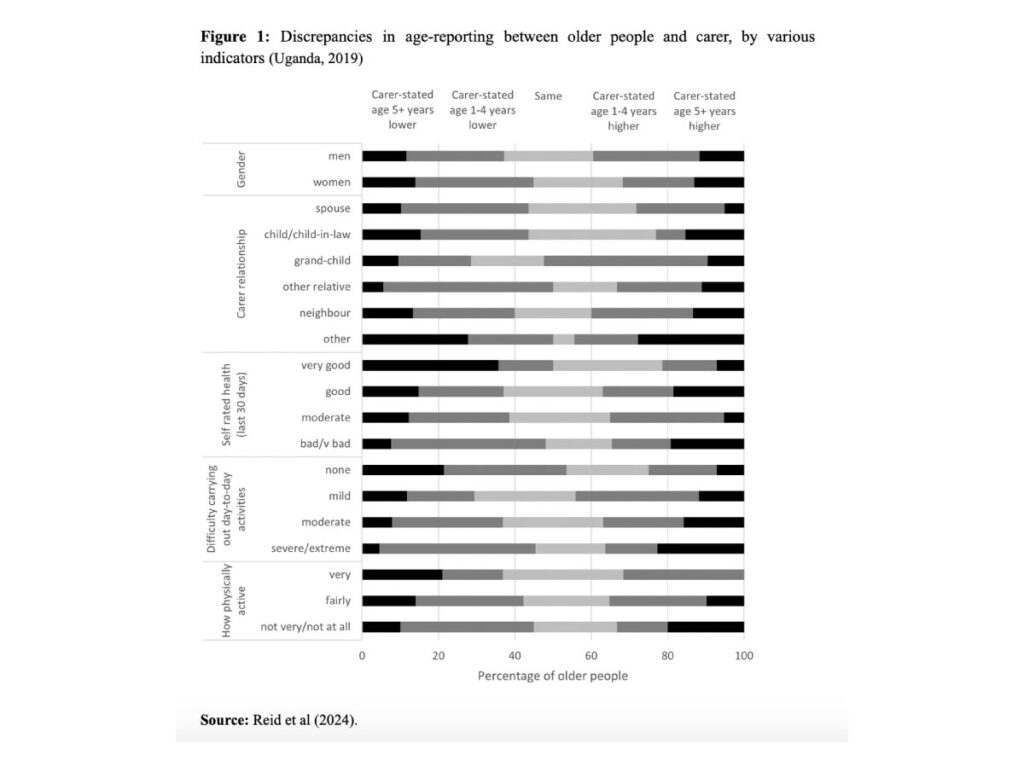The implications of inaccurate age-reporting among older people are rarely investigated. Alice Reid, Allen Kabagenyi, Stephen Wandera, Joshua Beinomugisha and Sarah Walters suggest that age-heaping may have more to do with registration systems than human capital, and illustrate how healthier old people are judged by others to be younger.
It is difficult, if not impossible, to conduct research on ageing without relying on reported age – if only to identify older people. Ageing research and policy are both therefore jeopardised by widespread age-misreporting, which is common among older people in low- and middle-income coutries (Randall and Coast, 2016). Here we discuss influences on the way that age is reported by and for older people in Uganda, Africa, using a pilot study of a peri-urban community.
Age reporting by older people: age-heaping, literacy and population registration
Age-heaping is the tendency to report ages in round numbers, usually numbers ending in zero or five. Many studies have found that age-heaping is higher in societies with low levels of education or literacy, and this has often been interpreted as a causal relationship, implying that uneducated people are unable to keep track of, or calculate, their age (Mba, 2014). This has led to the use of age-heaping as one of the most frequently used measures of numeracy and human capital (Crayen and Baten, 2010).
In our study, people with high human capital (who could read, write, and had more education) were more likely than those with lower human capital to report a birth date with a day and month as well as a year. In addition, their birth date was more likely to be consistent with the age they reported. Contrary to expectation, however, they were more likely to report an age ending in a 0 or 5 than were those with lower human capital, as shown by Table 1. The relationship between human capital and age heaping, independent of other factors, was confirmed using a multivariate logistic regression (Reid et al, 2024).

We suggest that the answer to this paradox is linked to the introduction of national ID cards five years before our survey took place. For many people these cards were the first document they had ever received with a date of birth, and this date was likely derived from a rounded age assigned when the card was issued. This date of birth therefore also yielded a round age during our survey. People with ID cards were more likely to report their birth date with high precision than those without, and were also more likely to report a date of birth consistent with the age they reported. People with high human capital were no more likely to have an ID card, but they may have been more likely to report a rounded age because they were quicker to sign up for ID cards and to have received one five years before the survey. Alternatively, they may have been more likely to consult or refer to their ID card and therefore to have learnt their assigned birth date.
Although we disagree that age heaping is an accurate indicator of numeracy, correlation between the two are common because the development of education and numeracy has often gone hand-in-hand with the introduction of registration and the growing requirement to report age or date of birth. However for today’s older generations in Uganda, and probably other societies too, we should be wary of interpreting age-heaping as an indicator of low social capital.
We argue that age reporting is a better measure of administrative modernisation (Spennemann, 2017; A’Hearn et al, 2022), than of human capital and that the registration of births and issuing of birth certificates is likely to be crucial. If large segments of the population receive identification at the same time, this can introduce patterns of age-heaping among those segments. The current push for much needed registration and identity documentation may not, therefore, be accompanied by immediate improvements in age reporting among the elderly.
Age reporting for older people: frailty as an indicator of perceived age
We also investigated factors which affected how others estimate the age of an older person. This is important because there are many circumstances where a person provides information on behalf of other household members. Table 1 also indicates that the ages of older people as reported by their carers are less precise than ages reported by the older people themselves. We investigated the presence of systematic patterns in this imprecision by comparing the age that an older person’s carer or companion thought they were with the age reported by the older person themself (discrepancies could be due to mis-reporting by either party).
We found that, compared to the carers of older people in poor health (according to several measures), the carers of older people in better health were more likely to allocate an age at least five years younger than the age reported by the older person themself (Figure 1). Interestingly, the same pattern was true for the relatives or carers of people who could write (not shown in Figure 1). It is possible that those who can read and write appear more mentally agile to others than those who cannot. Compared to spouses (who are more likely to know how old their husband or wife is, or believes themself to be), all other carers were more likely to report a much older age than the older person themself, especially when the carer was not a relative or neighbour.

Our finding that proxy reports of age are likely to be informed by health or appearance can compromise comparisons of healthy life expectancies and differences between groups within places, between different places, and over time, as different cultures and norms as well as underlying health status may affect assessments of age.
Our research also raises questions about the definitions of age. Peri-urban societies in Uganda currently use a primarily social-role or capability-based definition of old age although this may change in younger generations. Chronological age – although crucial for population modelling and forecasting – is not always a good indicator of biological age, which may be more important for defining vulnerability and related interventions.
References
A’Hearn, B., Delfino, A. and Nuvolari, A. (2022) Rethinking age heaping: a cautionary tale from nineteenth‐century Italy†, The Economic History Review, 75(1), 111–137, doi: 10.1111/ehr.13087.
Crayen, D. and Baten, J. (2010) Global trends in numeracy 1820–1949 and its implications for long-term growth, Explorations in Economic History, 47(1), 82–99, doi: 10.1016/j.eeh.2009.05.004.
Mba, C.J. (2014) “Examining the Accuracy of Age-Sex Data: An Evaluation of Recent Sub-Saharan African Population Censuses.”, in Odimegwu, C.O. and Kekovole, J. (eds.), Continuity and Change in Sub-Saharan African Demography. 1st ed., Routledge. pp 12–36.
Randall, S. and Coast, E. (2016) The quality of demographic data on older Africans, Demographic Research, 34, 143–174, doi: 10.4054/DemRes.2016.34.5.
Reid, A., Kabagenyi, A., Wandera, S.O., et al (2024) Age reporting by and for older people in Uganda: relationships with frailty, human capital and population registration, Journal of Global Ageing, 1(1), 27–51, doi: 10.1332/29767202Y2023D000000003.
Spennemann, D.H.R. (2017) Age Heaping among Indian Hawkers in South-eastern Australia and their source communities in the Punjab, JSPS, 24(1 & 2), 149–202.


